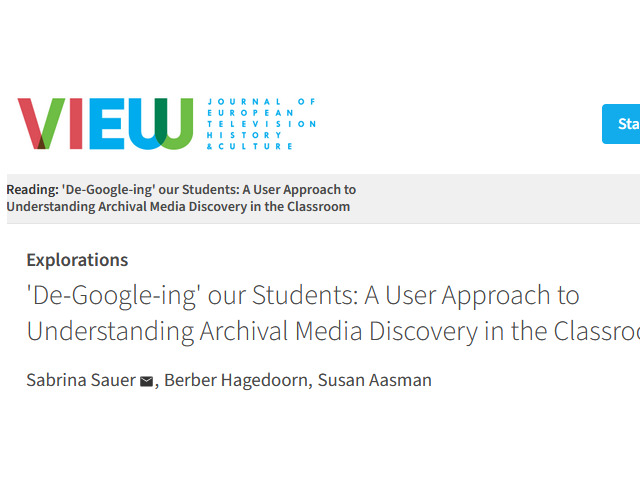Open access publication in the spotlight - 'De-Google-ing' our Students: A User Approach to Understanding Archival Media Discovery in the Classroom
| Date: | 29 April 2025 |
| Author: | Open Access Team |

Each month, the open access team of the University of Groningen Library (UB) puts a recent open access article by UG authors in the spotlight. This publication is highlighted via social media and the library’s newsletter and website.
The article in the spotlight for the month of April 2025 is titled 'De-Google-ing' our Students: A User Approach to Understanding Archival Media Discovery in the Classroom, written by Sabrina Sauer, Berber Hagedoorn and Susan Aasman (all from the Faculty of Arts).
Abstract
This article presents insights about how practices of record-keeping are understood by users of algorithmically curated audiovisual archives in a classroom setting. Our user study looks at the intersection of curated access to digital archives and actual use of these archives, between algorithmic practices and intermediated search. We discuss a pedagogical approach that facilitates learning about the ways in which data-orientated reconfigurations of archival content afford serendipitous information encountering at the data (content) level and the intermediated search (interface) level. This approach requires a ‘de-Google-ing’ (or de-Googling) of student search practices and a move from user-centred to artifact-orientated search regimes.
We asked the authors few questions about the article.
What do you mean with ‘De-google-ing our students’ and why is it important?
Searching online often means searching using a search engine, like Google, that presents users with a “white box” to enter a search query. This catch-all white box is what people have come to expect when they search or browse online. However, what happens when a user wants to search within a library or digital archive that uses a specific search system with alternative functionalities? In our article, we discuss how to teach users – in our case, media students – how to search in online audiovisual archives’ search systems. This means that students learn to critically reflect on their own search skills, and how to refine these also in non-academic situations as a form of digital literacy.
You mention that paying continuous attention to the craft of searching within the academic curriculum is important. How should this be embedded in the curriculum? And what role does the library’s information literacy training play in this?
Library information literacy training is key to academic training; without the skills to find what has been published about a topic you are interested in, for instance, you will not be able to contextualise your own research objectives. Moreover, it is often through search and browsing for information, that you can also gain surprising yet useful (or serendipitous) insights. This means that apart from searching and evaluating found references, the craft of searching also implies that users apply their digital search skills to engage in curiosity-driven searching to find unexpected source material.
Understanding search as a craft means that you learn how to use all kinds of search systems, whether this is an institutional, professional archive, or an online platform like YouTube. Our research focuses on teaching Media Studies and Digital Humanities students the craft of searching with tools of the CLARIAH Media Suite. The Media Suite offers access to Dutch archives such as the audiovisual archive of Netherlands Institute for Sound and Vision. It would be wonderful if the library’s information literacy training could incorporate training on how to search within research infrastructures with Media Suite-tools.
How did you select the journal in which to publish?
VIEW is an open access multi-media journal that focuses on European television history and culture. Our article is published in a special issue about storing, structuring and accessing audiovisual content in times of digital curation. This theme is highly appropriate for our research, as we – as Media Studies and Digital Humanities scholars – teach about new media archives, cultural heritage, digital curation and the implications of algorithmic culture on our research fields.
Could you reflect on your experiences with open access and open science in general?
Open science and open access are the only viable way to move forward in scholarship as openness allows researchers to develop an interdisciplinary understanding of how to tackle common issues.
Useful links:
-
VIEW is a diamond open access journal. Diamond open access journals are free to access/read and free to publish in, authors don’t need to pay article processing charges. The University of Groningen supports several diamond open access initiatives, see this overview.
-
University of Groningen Press (UGP) is an open access publisher that also publishes multiple diamond open access journals.
Citation:
Sauer, S., Hagedoorn, B., & Aasman, S. (2024). “De-Google-ing” our Students: A User Approach to Understanding Archival Media Discovery in the Classroom. VIEW Journal of European Television History and Culture, 13(26), 47–61. https://doi.org/10.18146/view.329
If you would like us to highlight your open access publication here, please get in touch with us.


